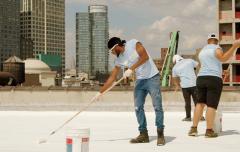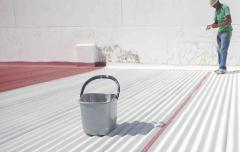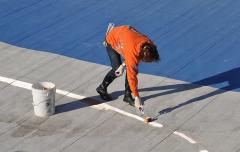Million Cool Roofs Challenge: Local Champions for a Global Movement
Cooling is essential to modern life. Whether it’s refrigerating food and vaccines along the supply chain, or keeping people cool in their homes, schools, or places of work, we need cooling to ensure quality of life and productivity. Yet somehow, over 1 billion people around the world currently lack access to cooling. This needs to change.
With the ultimate goal of accelerating access to affordable, sustainable cooling, the Million Cool Roofs Challenge was launched in 2019 to rapidly scale up the adoption of ‘cool’ roofs in developing countries where temperatures are high and access to cooling is low.
The Challenge— an initiative of the Clean Cooling Collaborative (formerly K-CEP), Global Cool Cities Alliance, Sustainable Energy for All (SEforALL), and Nesta Challenges — awarded grants of $125,000 to 10 teams across the world to test different approaches and models to scaling up cool roofs in their countries. The team that demonstrated the most effective, sustainable, and scalable model for stimulating rapid deployment of cool roofs would win the Challenge’s final prize of $750,000.
Cool roofs for cooler buildings and a cooler planet
Cool roofs are often considered a “win-win” strategy for climate action and sustainable development due to their simplicity, cost-effectiveness, and ease of adoption, with relatively inexistent drawbacks. By applying a solar-reflective coating to a building’s roof, less of the sun’s radiation is absorbed by the building, which can reduce its internal temperatures by 2-3°C. When deployed across a whole community, cool roofs can reduce local ambient temperatures and help lessen the urban heat island effect. In addition to increasing thermal comfort for the billions of people who do not have the economic means to access mechanical cooling options (e.g., air conditioning, fans, etc.), cool roofs can help reduce the need for mechanical cooling, in turn reducing energy demand and cutting greenhouse gas emissions. Further, the deployment of reflective materials creates sustainable job and skills opportunities for low-skilled workers in both rural and urban settings.
One million cool roofs
To date, over 1.1 million square meters of new cool roofs have been installed by the Challenge’s 10 teams, despite many obstacles brought on by the Covid-19 pandemic. That’s an area equivalent to 250,000 small household rooftops.
As the Challenge comes to an end, teams have made some fantastic progress and seen some promising results. Most teams have reported indoor temperature reductions of at least 2°C, with some teams seeing temperatures drop between 4.4°C and 10°C. They’ve also helped to create hundreds of training and job opportunities in local communities; reduce cooling demand and realize energy savings; and boost thermal comfort for building occupants like school children, hospital patients, and factory workers. Possibly the most important outcome of the Challenge has been the creation of a lasting legacy in participating countries and beyond. The competition has helped build a foundation for longer-term transformation ranging from raising awareness of cool roofs and developing local and regional production/supply chains, to changing building practices and influencing government policy like building codes and cooling action plans.
It’s encouraging to know that the impacts of the Challenge will be felt long after it ends.
And the winner is…
Due to the effectiveness of their project, their collaborative approach, and their plans for scaling up their work, Cool Roofs Indonesia has been selected as the winning team of the Million Cool Roofs Challenge and its $750,000 prize.
During the Challenge, the team installed cool roofs on 70 buildings across 15 cities in Indonesia, including 36 low-cost housing units, 10 schools, two factories, and one orphanage. In total, the team estimates that 10,250 people will benefit from the newly installed cool roofs. The Indonesian team saw some of the Challenge’s most impressive reductions in indoor temperatures. At one industrial site, indoor temperatures dropped by 10.7°C (from 40°C to 29.7°C) following the application of the cool roof coating. And at an elementary school, indoor temperatures were reduced by around 3°C (from 36°C to 33°C).
Indonesia is home to over 46.5 million people who are at high risk from a lack of access to cooling. Due to a combination of insecure electricity supply, poor quality housing, and unaffordable air conditioning, many within these communities will face heat stress on a daily basis. The temperature reductions being seen during the Challenge could have a significant impact on the lives of Indonesia’s lower-income communities.
What next for cool roofs in Indonesia?
During the Challenge, Cool Roofs Indonesia helped create and support over 100 manufacturing and installation jobs by establishing its own production capacity. The team hopes to boost employment opportunities further by working to scale up the local production of cool roof coatings as the program moves into its next phase. Through scaling up local production, they expect to reduce the cost of producing cool roof materials by around 20%, making cool roofs even more accessible.
As a part of their efforts to boost local production, Cool Roofs Indonesia is planning to set up the country’s first testing facility for solar reflective materials to ensure product quality and performance. They also plan to produce academic research to further highlight the importance and effectiveness of cool roofs in the Indonesian context.
The team has plans to work alongside government ministries to build on the successes of their Million Cool Roofs Challenge project and develop policy (e.g., national standards, building codes, etc.) that will facilitate the continued adoption of cool roofs across the country.
According to Beta Paramita, Assistant Professor of Architecture at Universitas Pendidikan Indonesia and Project Manager of Cool Roofs Indonesia, there are two key factors for deploying cool roofs at scale: ensuring you have a stable production and supply chain; and securing the support of trusted voices within the local context (e.g., academia). Beta’s advice fits nicely with the team’s approach both during the Challenge and for the next phase of their project.
While the Challenge has come to an end, the real challenge is just beginning. We’re excited to see how Cool Roofs Indonesia and the other nine finalists carry the Million Cool Roofs legacy forward to help make clean cooling accessible to all.
SEforALL Note: This post was originally published by Clean Cooling Collaborative and can be found here




